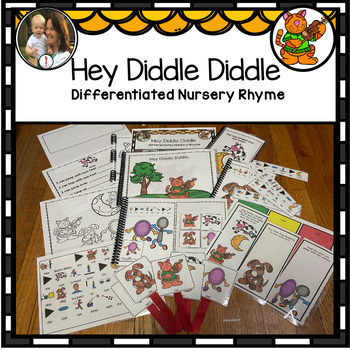Hey Diddle Diddle: Differentiated Nursery Rhyme Activities
- PDF
Also included in
- Interactive Adapted Songs, Poems, Seasonal, Nursery Rhymes, and a Choice Board BundleDo you work with mixed groups? I have found that if I can use the same content with different supports that my groups go smoother. Even if I am working with students one on one being able to use the same theme or sPrice $64.94Original Price $92.77Save $27.83
- Introducing the Nursery Rhymes Adapted Bundle - a captivating and informative bundle perfect for both parents and educators who want to help their children develop an understanding of stories, sequencing, memory skills, and more. This bundle contains some of the most popular nursery rhymes that arePrice $36.61Original Price $58.11Save $21.50
- #DistanceLearningTPT Hey Diddle Diddle Nursery Rhyme Print and Digital Activities. Perfect for your toddler, preschool, or kindergarten class with different activities for this rhyme. There are times that you want to be able to have some print resources for your students so that they can actively bPrice $3.76Original Price $4.70Save $0.94
Description
Hey, Diddle Diddle is a differentiated printable nursery rhyme resource that supports language development. It has active learning resources, writing prompt, following directions, and sequence task. The rhymes assist the students in learning vocabulary and practice phonemic awareness. Learning these poems by heart assist in developing auditory memory skills. Preschool and Kindergarten Standards
Mother Goose Rhymes introduce students to literature that has been passed down for generations.
Hey Diddle Diddle Contents:
•The first part is the rhyme in large pages.
•The second part is appropriate for those children that are readers, or it can be read to the child.
•The third part is a black and white book.
•The fourth part has pictures and words in a rebus read.
•The fifth part has both the rebus read as well as a place for single pictures as an interactive book.
•The sixth part has a lyric sheet
•The seventh part has visuals for active learning, following directions sheet, jumping activity
•The eighth part is a coloring page.
•The ninth part is a writing and drawing project.
•The tenth part is a sequence
I find that I have a variety of students that I work with and having the same story in several different editions helps to support all my students. I store them in a folder then give each child the edition that is appropriate for them.
I use this story for a variety of students from students
Preschool, kindergarten, and first graders as part of a poem choice
Fluency cases to practice smooth speech
Beginner readers
These are activities that I do with this poem:
Say the Poem: There are four different booklets, reader, rebus reader, rebus reader plus adapted pictures, and a lyric page.
Sequence the Poem: This is a great poem to teach sequencing. I have included a sequence board ( First, Then, Last). I have also included a three-part sheet that can be cut apart to have the child put them in the correct sequence.
Follow Directions: I have included pictures that can either be used for play-acting or can be used for following directions.
Coloring Page: This can be used a take home for the child to bring the poem home.
.Active Learning: Jumping activity and play-acting
Writing Activity: I love being able to connect what we are doing verbally with a written activity to tie the language together.
PRESCHOOL ( Core Knowledge)
Language
•Movement
II-MC5.3: Act out a nursery rhyme, poem or fingerplay.
•Memorization
1-NRI.1a: Memorize and recite with others a simple Critical Skill nursery rhyme, poem or song
1-NRI.1bMemorize and recite with others a simple Critical Skill nursery rhyme, poem or song
KINDERGARTEN STANDARDS ADDRESSED:
•RF.K.1: Demonstrate understanding of the organization and basic features of print.
•RF.K.2: Demonstrate understanding of spoken words, syllables, and sounds.
•RF.K.2.a: Recognize and produce rhyming sounds.
•RF.K.3: Know and apply grade-level phonics and word analysis skills in decoding words.








